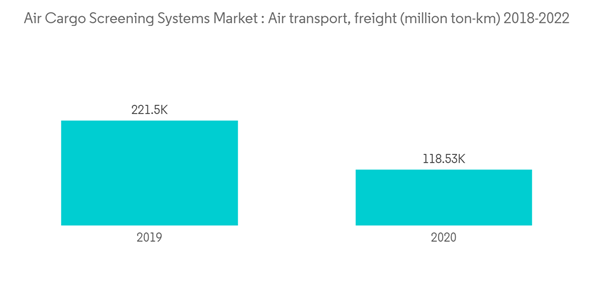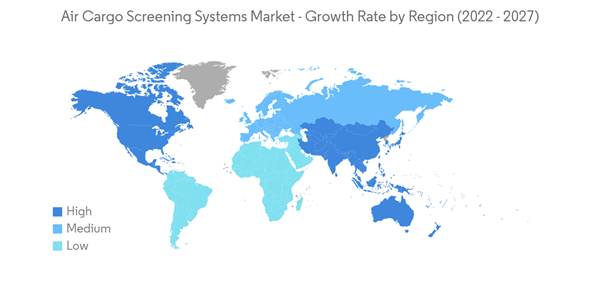The air cargo screening systems market is expected to grow with a CAGR of more than 4% during the forecast period.
The global aviation sector faced unprecedented challenges due to the COVID-19 pandemic. The pandemic significantly affected the commercial aviation sector, drastically reducing passenger traffic, negatively affecting demand for airport equipment, and delaying procurement plans and replacement/MRO cycles. According to the International Air Transport Association (IATA) report, the global market for air cargo witnessed a significant decline in the base year. Asia-Pacific airlines saw their air cargo volumes decrease by 10.7% in September 2022 compared to the same month in 2021. Furthermore, the cargo traffic between North America-Asia trade lanes decreased by 2.4% due to factory closures in Asia amid COVID-19 pandemic. Such factors reduced the demand for air cargo screening systems during the pandemic.
The rapid expansion of the aviation sector and increasing investments in the modernization of airport infrastructure drive the market’s growth. In the last few years, e-commerce has witnessed significant growth due to increased online shopping, leading to rapid air cargo volume growth. This is expected to generate demand for advanced screening systems at airports to handle cargo of various sizes and types. With the increase in air cargo, several airports are constructing dedicated air cargo terminals, which are expected to further propel the demand for air cargo screening systems in the coming years. The air cargo industry is a large target for terror attacks. In the past, few attempts were made to ship explosive materials, which raised concerns and resulted in further tightening regulations in terms of screening. Stringent regulations related to air cargo screening by the Transportation Security Agency (TSA) and other regulatory bodies in the European Union forced several airports to enhance existing cargo screening systems.
Investments in newer technologies of explosive and narcotics trace detection equipment will likely help the government prevent or reduce terrorism. Technological advancements and a shift towards cost-effective and reliable explosive and drug trace detection devices will create lucrative opportunities in the upcoming years. Hence, investment in such technologies is projected to drive the segment's growth during the forecast period.
According to the IATA report, the overall air cargo volumes increased by 6.9% in 2021 compared to 2019. Furthermore, the IATA report stated China would surpass the United States and become the largest aviation market. In contrast, India will reach the United Kingdom to become the third-largest aviation market in 2024. Thus, the increasing number of airports leads to the growing demand for air cargo screening systems during the forecast period.
In March 2022, Smiths Detection’s HI-SCAN 10080 XCT X-ray computed tomography system received approval on the United States TSA air cargo screening technology list (ACSTL). Additionally, in April 2021, Smiths Detection Inc. launched a new lithium batteries algorithm for its air cargo and checked baggage screening system, HI-SCAN 10080 EDX-2is. It automatically detects lithium batteries in all baggage and freight screened for explosives.
This product will be delivered within 2 business days.
The global aviation sector faced unprecedented challenges due to the COVID-19 pandemic. The pandemic significantly affected the commercial aviation sector, drastically reducing passenger traffic, negatively affecting demand for airport equipment, and delaying procurement plans and replacement/MRO cycles. According to the International Air Transport Association (IATA) report, the global market for air cargo witnessed a significant decline in the base year. Asia-Pacific airlines saw their air cargo volumes decrease by 10.7% in September 2022 compared to the same month in 2021. Furthermore, the cargo traffic between North America-Asia trade lanes decreased by 2.4% due to factory closures in Asia amid COVID-19 pandemic. Such factors reduced the demand for air cargo screening systems during the pandemic.
The rapid expansion of the aviation sector and increasing investments in the modernization of airport infrastructure drive the market’s growth. In the last few years, e-commerce has witnessed significant growth due to increased online shopping, leading to rapid air cargo volume growth. This is expected to generate demand for advanced screening systems at airports to handle cargo of various sizes and types. With the increase in air cargo, several airports are constructing dedicated air cargo terminals, which are expected to further propel the demand for air cargo screening systems in the coming years. The air cargo industry is a large target for terror attacks. In the past, few attempts were made to ship explosive materials, which raised concerns and resulted in further tightening regulations in terms of screening. Stringent regulations related to air cargo screening by the Transportation Security Agency (TSA) and other regulatory bodies in the European Union forced several airports to enhance existing cargo screening systems.
Air Cargo Screening Systems Market Trends
Explosive Trace Detection Systems are Expected to Lead the Market During the Forecast Period
Explosive trace detectors (ETD) detect small-magnitude explosives. Devices similar to ETDs are used to detect narcotics. Modern screening methods are proficient and powerful in screening high volumes of cargo. Explosive Trace Detection systems dominated the market in 2022 due to their capability to detect minute traces of illegal/prohibited items and narcotics. ETDs are used in many airports as this technology is used to detain people handling drugs and explosives and to identify traffickers of prohibited material. For instance, in February 2021, Rapiscan systems received TSA air cargo approval for its Itemiser 5X trace detector. It is designed to process trace sample swabs from various sources, such as clothing, packages, cargo, and others, in under eight seconds. It is ideal for explosive and narcotics detection in cargo screening at airports, border patrol, prisons, and other security events.Investments in newer technologies of explosive and narcotics trace detection equipment will likely help the government prevent or reduce terrorism. Technological advancements and a shift towards cost-effective and reliable explosive and drug trace detection devices will create lucrative opportunities in the upcoming years. Hence, investment in such technologies is projected to drive the segment's growth during the forecast period.
The Asia-Pacific is Estimated to Show Highest Growth During the Forecast Period
Asia-Pacific is anticipated to show remarkable growth during the forecast period. The change is attributed to rising cargo traffic, a growing number of airports, and increasing expenditure on the aviation sector from emerging economies such as China and India. In Asia-Pacific, major countries like China, India, Japan, and Singapore are planning to construct new airports and expand the existing airports. In February 2020, the Indian government announced 100 new airports are to be built by 2024. The new airports will have dedicated terminals for cargo which will further propel the demand for screening systems from this region during the forecast period. In June 2022, the Union Civil Aviation Minister of India announced the country will have 33 additional cargo terminals by 2024-2025.According to the IATA report, the overall air cargo volumes increased by 6.9% in 2021 compared to 2019. Furthermore, the IATA report stated China would surpass the United States and become the largest aviation market. In contrast, India will reach the United Kingdom to become the third-largest aviation market in 2024. Thus, the increasing number of airports leads to the growing demand for air cargo screening systems during the forecast period.
Air Cargo Screening Systems Market Competitor Analysis
The airport ground support vehicles market is fragmented and characterized by several suppliers providing various cargo screening systems. However, some prominent players in the market are Leidos Inc., Rapiscan System Inc., L3 Security & Detection Systems, Smith’s Detection Inc., and VOTI Detection Inc. With the growing competition in the industry, manufacturers of screening systems are adopting advanced technologies and significantly increasing investment in R&D.In March 2022, Smiths Detection’s HI-SCAN 10080 XCT X-ray computed tomography system received approval on the United States TSA air cargo screening technology list (ACSTL). Additionally, in April 2021, Smiths Detection Inc. launched a new lithium batteries algorithm for its air cargo and checked baggage screening system, HI-SCAN 10080 EDX-2is. It automatically detects lithium batteries in all baggage and freight screened for explosives.
Additional benefits of purchasing the report:
- The market estimate (ME) sheet in Excel format
- 3 months of analyst support
This product will be delivered within 2 business days.
Table of Contents
1 INTRODUCTION
4 MARKET DYNAMICS
5 MARKET SEGMENTATION
6 COMPETITIVE LANDSCAPE
Companies Mentioned (Partial List)
A selection of companies mentioned in this report includes, but is not limited to:
- Rapiscan System Inc.
- L3 Security & Detection Systems
- Smiths Detection Inc.
- Leidos Inc.
- VOTI Detection Inc.
- 3DX-RAY
- Teledyne UK Limited
- Astrophysics Inc.
- ICTS Europe SA
- Gilardoni SPA
- Autoclear LLC
- EAS Envimet Analytical Systems GesMBH
Methodology

LOADING...










